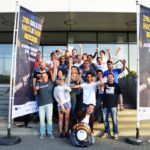
As part of its effort to achieve the highest return on European GNSS investment, in terms of benefits to users and economic growth and competitiveness, the GSA has worked very hard to get Galileo into smartphones. It’s an effort that has paid off.
The first European smartphones incorporating Galileo were launched in 2016, starting with the BQ Aquaris x5 and followed by the Huawei Mate 9. Three more, the Huawei P10, Sony Xperia XZ premium and Samsung S8, joined the ranks of the Galileo-ready this year.
“We have the consumer devices, now it is time to take the next step and enable actual applications,” said GSA Market Development Officer Justyna Redelkievicz, speaking at the 2017 Galileo Hackathon in Gdynia, Poland. “That is why we are here at the second Galileo Hackathon, to work with developers to create applications that bring real benefits to European users.”
Ready, set, hack!
Participants had approximately 22 hours to come up with innovative applications using Galileo services that brought added commercial or societal value. Thanks to Hackathon technology partner Samsung, each team was provided with a Galileo-enabled Samsung S8+ Android smartphone to use during the contest. The phones feature Android 7.0 (i.e. Nougat), which gives application developers access to raw GNSS measurements directly from the Samsung phone, and hence higher accuracy.
Although these measurements are beneficial, the average application developer doesn’t necessarily know how to use them. “They might not know what a pseudorange is because they simply have not been trained in this area, not in the way, for example, that today’s surveyors are trained,” said Redelkievicz.
To help make life easier for the Hackathoners, teams also had access to a plug-and-play stack, provided courtesy of Hackathon partner HyperTrack. “Hypertrack is a location stack that enables developers to add live location features into their app in a short period of time,” explained HyperTrack Community Manager Jeremy Meiss. “With just a few lines of code, developers can completely avoid the pain of having to build their own location services with the back end, the front end and the GPS logic.”
In addition to this support, throughout the event, support staff, experts and organisers circulated among the hacking teams, providing advice, technical support and moral encouragement – not to mention vital food and drink. “At the very beginning, people were a little bit lost, but after having spoken with them and been given some guidelines, I think we ended up having some really nice ideas,” said Navarro-Gallardo. “It’s just 24 hours, but we have ideas, maybe one of which will lead to something important in the future.”
And the winners are…
Following the final presentations and after some tough deliberation among the jury, three winning teams – ‘ENAC Team’, ‘CDV’ and ‘Midnight Coders’ – were chosen to receive EUR 1,000 cash prizes and a chance to shine at a special awards ceremony on the InfoShare 2017 mainstage.
“There were a lot of terrific concepts and it was great to be a part of what the GSA is doing as they enable Galileo access for developers,” said Meiss.
“Coming from tech side, where the focus is on developing satellites, it’s very exciting and very rewarding for me to also see what the application developers can do with the Galileo signal,” added Sirikan.
Building awareness
With the second Galileo Hackathon now officially in the books, it’s safe to say the event succeeded at what it set out to do: expand the Galileo user community. After all, the more apps utilising the full power of Galileo there are, the more people buying new phones will realise and understand the importance of precise location.
“We hope that one day people will know what it means to choose a phone that uses two or four GNSS constellations versus just one,” added Redelkievicz. “Instead of just looking at the size of the screen, the brand name and the camera quality, they will also have an awareness of the location quality. Getting to this point, however, requires education – which is exactly what we are doing here at the Galileo Hackathon.”
